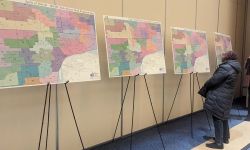Redistricting may oust half of incumbents in Michigan, analysis finds
LANSING — In the state House, Flint is represented by Democrats Cynthia Neeley and John Cherry, even though they live less than 3 miles apart within the city.
Related stories:
- Michigan redistricting panel’s maps spark racial backlash, fairness questions
- Facing backlash, Michigan redistricting commissioners may adjust maps
- Michigan redistricting commission relents, creates majority-Black maps for House
But starting next year, they would be consolidated into the same district, according to all four maps under consideration by the Michigan Independent Citizens Redistricting Commission.
Independent commission’s proposed maps
The redistricting commission has put forward 15 maps that would redraw the boundaries of Congressional, state House and state Senate districts. To see how they look, and to see which districts you live in, click on the links below. They take you to the commission’s own maps.
State House
State Senate
- Cherry V2
- Palm
- Linden
- Commissioner Brittni Kellom Senate Map
- Commissioner Rhonda Lange Senate Map
- Commissioner Szetela Senate Map
Michigan Congressional
The Rev. Alfred L. Harris of Flint called those proposals a “disgrace,” and he worries that Flint, a city that’s 54 percent Black, could be without a Black representative in the state House. Neeley is African American.
“I mean, that’s just going backwards,” Harris told Bridge Michigan.
Similar changes could come next year throughout Michigan, as up to half of all seats in the state House and Senate next year could have new representatives because of redistricting and term limits, according to a Bridge Michigan analysis.
Legislative districts are redrawn every 10 years after the completion of the U.S. Census. This is the first year an independent panel — rather than politicians — is drawing the districts, and it’s clear the group’s 13 members didn’t take incumbency into consideration.
The commission is weighing 15 maps total, and the public can comment on them until Dec. 28, when the panel is expected to adopt districts for the state Legislature and Michigan’s delegation to the U.S. House.
Bridge Michigan analyzed the commission’s maps, compared them to current addresses of lawmakers, and found there are up to three dozen proposed state House and Senate and U.S. House districts without an incumbent when the maps take effect in 2022.
Similarly, the commission has created as many as 11 districts where state lawmakers would have to move or face off against each other. In Saginaw County, for instance, Reps. Rodney Wakeman, R-Saginaw Township, and Amos O’Neal, D-Saginaw, would live in the same district in three of the four proposed maps. They live less than 5 miles from each other.
Many incumbents, of both parties, will be unhappy regardless of which maps are approved. Consider:
- U.S. Reps. Bill Huizenga and Fred Upton, both Republicans, will now live in the same west Michigan district.
- U.S. Rep. Brenda Lawrence, D-Southfield, faces Reps. Andy Levin or Debbie Dingell, both Democrats, in every map. Lawrence this week said she may sue the redistricting panel if it doesn’t create more majority-minority districts, the news site Gongwer reported.
- U.S. Rep. John Moolenaar, R-Midland, faces U.S. Rep. Dan Kildee, D-Flushing, in four of the five maps, despite living just a few miles from his old district that runs to the north and west of Midland.
- State Rep. Matt Hall, R-Marshall, chair of the House Tax Policy Oversight Committee, lives in the same district as fellow Republican Rep. Sarah Lightner of Springport in every proposed map.
- Aric Nesbitt, R-Lawton, president pro tempore of the state Senate, would face fellow Republican Kim LaSata of Bainbridge Township. In one proposed map, two term-limited House Republicans would also live in the district.
- Under several proposed maps, three of the 16 Democrats now in the 38-seat Senate — Rosemary Bayer, Mallory McMorrow and Marshall Bullock — would live in the same district.
Congressional map “Chestnut”
This map has three open seats and four in which current incumbents could face each other, including Democrats Brenda Lawrence and Debbie Dingell. Yet a seat that includes Ann Arbor has no incumbent. U.S. Rep. Elissa Slotkin, D-Holly, has said she’d move to the district that includes Lansing. This is one of five congressional maps.
Senate map “Linden”
This map has 14 open seats — six because of term limits — and four districts in which current incumbents face each other. In one district in Oakland and Wayne counties, three incumbent Democrats could face each other. This is one of six proposed state Senate maps.
House map “Hickory”
This map has 47 open seats — 24 because of term limits and 10 districts in which current incumbents could face each other, including Republicans Matt Hall and Sarah Lightner in Calhoun County. This is one of four proposed state House maps.
For this analysis, Bridge Michigan confirmed the addresses of all legislators with the fall 2020 voter records, which it obtained from the Michigan Secretary of State, and then used mapping software to determine in which districts they lived and whether they would face another incumbent. In terms of the Senate map, Bridge also mapped the locations of state representatives who are term-limited from running again.
The proposed changes are far more sweeping than previous rounds of redistricting, which were controlled by the party in power in Lansing and resulted in some of the most Republican gerrymandered districts in the nation.
Much of that process was behind closed doors — but ultimately had to be approved during an open vote of the Legislature, and the districts had to abide by a framework established by the courts.
Some of those old rules, such as drawing lines that keep county boundaries intact, no longer apply with the citizens panel.
Nor does the commission have to worry about wooing incumbents to vote for the new districts.
That’s quite a change from 2011 and 2001, when Republicans controlled the Legislature and “absolutely” knew where lawmakers lived, said Jeff Timmer, a GOP political consultant who helped draft those maps.
“We needed the votes,” he told Bridge Michigan.
Timmer said districts that pitted Republicans against one another — like those affecting GOP leaders Hall and Nesbitt — would never have been drawn, “because both would have squealed like a frightened Ned Flanders,” he said, referring to a character on “The Simpsons” TV show.
The new panel also must take population changes into account, but it can be creative about how it divides cities into districts.
House districts cover 90,000 people, and for years Flint had two representatives because its population was just over that threshold (about 102,000.)
In the last 10 years, Flint’s population fell 21,000, and is slated to lose one representative.
In contrast, Grand Rapids has added 10,000 people to 198,000 over the past 10 years — and is slated to be in four districts in one commission map, up from two now.
New maps, many new faces
Unless dozens of legislators intend to move, any of the 15 proposed maps could lead to an influx in inexperienced lawmakers in the Legislature.
Bridge’s analysis found that no fewer of 55 seats in the 110-district House will have new representatives in 2022 (24 because of term limits), compared to 18 who didn’t seek re-election in 2012.
In the 38-seat Senate, at least 17 districts will get new senators (six because of term limits) under the new maps, compared to 10 in 2014, the first election after the last redistricting.
“When you have a lot of new people that come in, there tends to be a lot of sort of ideological fervor and not a lot of expertise about how to accomplish stuff,” Adrian Hemond, a Democratic strategist, told Bridge Michigan.
Consider:
- In Congress, Michigan’s delegation is falling to 13 from 14 because of a stagnant population. In four maps proposed by the commission, three districts have no incumbent, while four districts would pit two incumbents against each other. The other map has two open districts and three contested districts.
- Of the four state House maps, there are 46 to 48 open seats out of 110 representatives either because no incumbent lives there or because of term limits. And nine or more districts have incumbents who would be forced to move or face off in a primary.
- Among the six maps of the 38 Senate districts, five have 14 open districts either because no one lives there or term limits. Each of the proposed maps has four contested districts; in one map, three Democratic Senate incumbents in Oakland and Wayne counties would live in the same district.
The new maps would appear to increase Democrats’ chance of flipping the state House or Senate, based on vote tallies from the 2020 and 2016 election. The congressional delegation, which is now 7-7, also may have a slight advantage for Democrats.
This is a significant change: Republicans have had the majority in the Legislature for years, despite sometimes getting fewer overall votes than Democrats in some elections.
Already, lawmakers have said they will move because of redistricting, including Dingell and fellow Democratic U.S. Rep. Elissa Slotkin of Holly — even though U.S. House members are not required to live in their districts.
State lawmakers are required to do so, however, and Bayer said she may move to an open district just northwest of her home in Beverly Hills in Oakland County rather than face fellow Democrats Bullock and McMorrow.
“Part of our major goal has to be — and I can't decide if it's No. 1 or No. 2 — but making sure that we win enough seats in Michigan, flip the Senate,” Bayer said. “So, none of us want to run against each other.”
Bullock, who lives in Detroit, northwest of Highland Park, didn’t respond to a request for comment from Bridge.
McMorrow, who lives 6 miles north of him in Royal Oak, said she’s not moving and is running for reelection. She told Bridge she and Bullock will grab “coffee or beer next week and talk it out.”
McMorrow said the new maps, despite putting incumbents together, are good news for Democrats.
“It’s our map to lose, frankly, because I feel very confident that when we're on fair turf, we can run and win,” McMorrow said.
Open seats
A big roster change in Lansing could create challenges, said Meghan Reckling, a GOP strategist who also serves as chair of the Livingston County Republican Party.
In a city already marked by gridlock, next year’s Legislature may have to allocate billions of dollars in infrastructure through COVID-19 relief funds or consider whether to tighten election laws.
“When we have such a large turnover, and you have a lot of legislators in both caucuses that don't know the legislative process, that puts a lot of power in the hands of staff and the people who have been in Lansing significantly longer than the legislators themselves,” Reckling said.
Bernie Porn, a longtime Michigan pollster who worked with Democrats in the 1980s and 1990s redistricting cycles, told Bridge new people could mean the candidates have to work harder to get votes.
Porn said eliminating partisanship was one of the reasons why voters approved the 2018 constitutional amendment that created the independent commission.
“The only way to get around (partisanship) is to have as many competitive districts where candidates have to try and appeal to both their own party and independent voters in order to win,” Porn said.
Regardless of incumbency or new faces, all of the proposed maps are already creating conversations among lawmakers regarding fundraising.
It’s clear that the next election cycle could be one of the most expensive ones in the state. Primaries, Reckling said, are the ones to watch closely.
“Under almost all of the maps, that majority is genuinely going to be in play,” Reckling said.
“So you're going to see both caucuses swinging for the fences to try to gain majority control over the Michigan House … You have many sitting members that are raising money and they're going to spend a lot of money to come out of this.”
See what new members are saying about why they donated to Bridge Michigan:
- “In order for this information to be accurate and unbiased it must be underwritten by its readers, not by special interests.” - Larry S.
- “Not many other media sources report on the topics Bridge does.” - Susan B.
- “Your journalism is outstanding and rare these days.” - Mark S.
If you want to ensure the future of nonpartisan, nonprofit Michigan journalism, please become a member today. You, too, will be asked why you donated and maybe we'll feature your quote next time!




